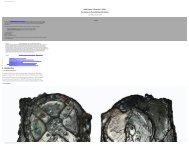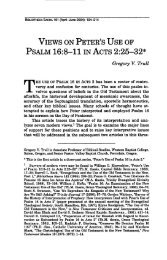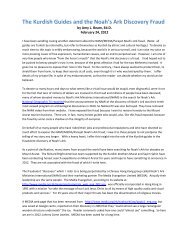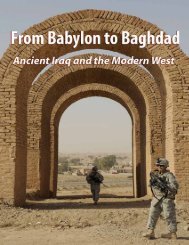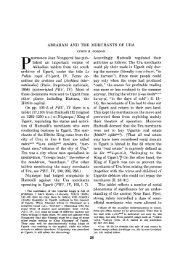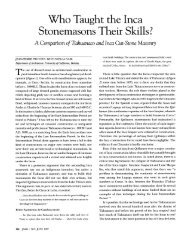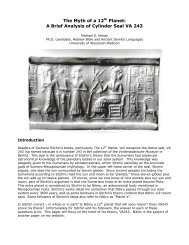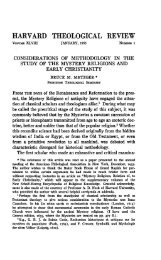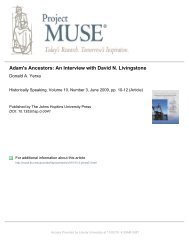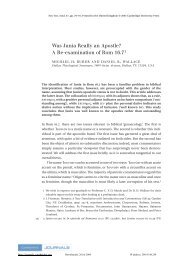Chariots of the Gods? and All That: Pseudo ... - Michael S. Heiser
Chariots of the Gods? and All That: Pseudo ... - Michael S. Heiser
Chariots of the Gods? and All That: Pseudo ... - Michael S. Heiser
Create successful ePaper yourself
Turn your PDF publications into a flip-book with our unique Google optimized e-Paper software.
<strong>Chariots</strong> <strong>of</strong> <strong>the</strong> <strong>Gods</strong>? <strong>and</strong> <strong>All</strong> <strong>That</strong>:<br />
<strong>Pseudo</strong>-History in <strong>the</strong> Classroom<br />
H. E. LEGRAND<br />
WAYNE E. BOESE<br />
Virginia Polytechnic Institute <strong>and</strong> State University<br />
A RE WE descendants <strong>of</strong> ancient astronauts? Was <strong>the</strong> flaming<br />
chariot <strong>of</strong> Ezekiel really a flying saucer? Were <strong>the</strong> pyramids <strong>of</strong> Egypt<br />
l<strong>and</strong>ing markers for visitors from ano<strong>the</strong>r planet? Was <strong>the</strong> manna given<br />
to Moses <strong>and</strong> his people part <strong>of</strong> a comet which later became <strong>the</strong> planet<br />
Venus? Did <strong>the</strong> ancient Babylonians have electric lights? Such<br />
provocative <strong>and</strong> bizarre questions have captured <strong>the</strong> imagination <strong>of</strong><br />
millions <strong>and</strong> evoked <strong>the</strong> hostility <strong>of</strong> scholars. Many students, from art<br />
to zoology, from English to electrical engineering, are quite receptive to<br />
<strong>the</strong> interpretations <strong>and</strong> methods <strong>of</strong> pseudo-scholars who espouse such<br />
ideas. This is, moreover, a phenomenon which extends to all levels <strong>of</strong><br />
higher education, as is made clear by <strong>the</strong> fact that week after week one<br />
or ano<strong>the</strong>r book endorsing such strange views is near <strong>the</strong> top <strong>of</strong> <strong>the</strong><br />
"What Students Are Reading" popularity chart published by <strong>the</strong><br />
The authors are both Assistant Pr<strong>of</strong>essors at Virginia Polytechnic Institute <strong>and</strong> State<br />
University, Mr. LeGr<strong>and</strong> specializing in <strong>the</strong> history <strong>of</strong> science <strong>and</strong> Mr. Boese in ancient<br />
history. Mr. LeGr<strong>and</strong> received his Ph.D. in <strong>the</strong> history <strong>of</strong> science from <strong>the</strong> University <strong>of</strong><br />
Wisconsin <strong>and</strong> has published articles in Isis, Annals <strong>of</strong> Science, Ambix, <strong>and</strong> Organon. He<br />
is currently on leave to serve as Visiting Lecturer at <strong>the</strong> University <strong>of</strong> Melbourne,<br />
Australia. Mr. Boese, who formerly taught history <strong>and</strong> German at Washington Senior<br />
High School in Sioux Falls, South Dakota, received his Ph.D. from <strong>the</strong> University <strong>of</strong><br />
Washington in 1973. He has published articles on ancient slavery <strong>and</strong> <strong>the</strong> teaching <strong>of</strong><br />
ancient history in Context <strong>and</strong> <strong>the</strong> South Dakota Social Science Association Journal.<br />
359
360<br />
PSEUDO-HISTORY<br />
Chronicle <strong>of</strong> Higher Education. Popularity <strong>of</strong> <strong>the</strong> subject matter alone,<br />
however, is not a sufficient justification for a course; o<strong>the</strong>rwise, courses<br />
on football, beer-drinking, <strong>and</strong> sex would be <strong>of</strong>fered at most<br />
universities.<br />
The popularity <strong>of</strong> strange views <strong>of</strong> <strong>the</strong> past is directly tied to<br />
certain academic concerns. Both students <strong>and</strong> <strong>the</strong> general public are for<br />
<strong>the</strong> most part unfamiliar with <strong>the</strong> methodology used by <strong>the</strong> historian<br />
<strong>and</strong> <strong>the</strong> archaeologist in sweeping away <strong>the</strong> dust <strong>and</strong> cobwebs from <strong>the</strong><br />
picture <strong>of</strong> man's slow ascent from barbarism. It is easy to ridicule, as<br />
pseudo-scholars <strong>of</strong>ten do, <strong>the</strong> efforts <strong>of</strong> an archaeologist who may spend<br />
his life establishing a chronology <strong>of</strong> Babylonian pottery or those <strong>of</strong> an<br />
historian announcing <strong>the</strong> fifteen-thous<strong>and</strong>th different interpretation <strong>of</strong><br />
<strong>the</strong> fall <strong>of</strong> <strong>the</strong> Roman Empire. Their efforts <strong>and</strong> achievements are not<br />
glamorous <strong>and</strong> <strong>the</strong>ir conclusions, couched in <strong>the</strong> dry <strong>and</strong> cautious<br />
language <strong>of</strong> scholars, rarely are noticed by <strong>the</strong> layman. It is not so<br />
surprising, <strong>the</strong>n, that students do not seek exposure to <strong>the</strong>se disciplines.<br />
This is most unfortunate, for <strong>the</strong>se men have collected <strong>the</strong> pieces <strong>of</strong> <strong>the</strong><br />
mosaic <strong>of</strong> our past <strong>and</strong> have established rules for fitting <strong>the</strong> pieces<br />
toge<strong>the</strong>r. The first rule is to base one's interpretation <strong>of</strong> past events on<br />
as broad a base <strong>of</strong> facts as possible. The scholar must above all be sure<br />
<strong>of</strong> his facts <strong>and</strong> avoid selecting only those that somehow fit his own<br />
preconceptions <strong>and</strong> pet <strong>the</strong>ories. To ignore evidence against one's view,<br />
to change <strong>the</strong> facts ra<strong>the</strong>r than <strong>the</strong> interpretation, to gloss over<br />
difficulties or inconsistencies is to forfeit one's reputation. Because this<br />
painstaking method is followed, historians <strong>and</strong> archaeologists have a<br />
well-founded aversion to filling in gaps in <strong>the</strong>ir evidence through sheer<br />
guesswork, since <strong>the</strong>y recognize that complex questions <strong>and</strong> events<br />
<strong>of</strong>ten require complex answers <strong>and</strong> analyses. As a result, <strong>the</strong>re remain<br />
many apparent "puzzles" or "mysteries" about <strong>the</strong> past. In some<br />
instances <strong>the</strong>re is no evidence; in o<strong>the</strong>rs, <strong>the</strong> evidence as to why certain<br />
events transpired is ambiguous. In <strong>the</strong>se cases, scholars rely on<br />
"might," "possibly," "perhaps," <strong>and</strong> "could have" instead <strong>of</strong> "must,"<br />
"had to," "did," <strong>and</strong> "because."<br />
Just as historical novels are more popular <strong>and</strong> thus more<br />
instrumental in <strong>the</strong> shaping <strong>of</strong> <strong>the</strong> general public's conception <strong>of</strong> <strong>the</strong><br />
past than <strong>the</strong> scholarly tomes on which <strong>the</strong>y are based, so are <strong>the</strong><br />
presentations <strong>of</strong> Erich von Daniken <strong>and</strong> o<strong>the</strong>rs <strong>of</strong> <strong>the</strong> same persuasion.<br />
These "strange views" <strong>of</strong>fer fancy in <strong>the</strong> guise <strong>of</strong> fact decked out in all<br />
<strong>the</strong> gaudy finery <strong>of</strong> pseudo-scholarship. They ignore counter-evidence<br />
<strong>and</strong> casually dismiss <strong>the</strong> work <strong>of</strong> pr<strong>of</strong>essionals in order to provide one<br />
solution to every difficulty, one culprit for every "mystery," one answer,<br />
whe<strong>the</strong>r spaceman or comet, to every question. <strong>Pseudo</strong>-scholars cite
THE HISTORY TEACHER<br />
361<br />
obscure (<strong>and</strong> <strong>of</strong>ten out-dated) sources, compiling hundreds <strong>of</strong> "facts" <strong>of</strong><br />
dubious accuracy or relevance which are <strong>the</strong>n trimmed <strong>and</strong> planed <strong>and</strong><br />
forced into a preconceived pattern.<br />
The best known radical interpretations are those <strong>of</strong> Immanuel<br />
Velikovsky <strong>and</strong> Erich von Daniken. Velikovsky in <strong>the</strong> 1950's ignited a<br />
controversy with geologists <strong>and</strong> astrophysicists which still burns today.<br />
Indeed, one <strong>of</strong> <strong>the</strong> more popular sessions <strong>of</strong> <strong>the</strong> 1974 American<br />
Association for <strong>the</strong> Advancement <strong>of</strong> Science meeting in San Francisco<br />
was a formal debate between Velikovsky <strong>and</strong> his scientist-critics.<br />
Velikovsky, a student <strong>of</strong> biology, medicine, rabbinical literature, <strong>and</strong><br />
numerous o<strong>the</strong>r subjects, argues that <strong>the</strong> planet Venus was actually a<br />
"comet" expelled from Saturn. This comet passed close to <strong>the</strong> earth<br />
about 1500 B.C. <strong>and</strong> for a period <strong>of</strong> about fifty years greatly perturbed<br />
<strong>the</strong> earth. These events coincide, he claims, with <strong>the</strong> Exodus <strong>of</strong> <strong>the</strong><br />
Hebrews from Egypt. Velikovsky <strong>the</strong>n attributes <strong>the</strong> plagues, <strong>the</strong><br />
parting <strong>of</strong> <strong>the</strong> Red Sea, <strong>the</strong> manna from heaven, <strong>the</strong> pillar <strong>of</strong> cloud by<br />
day <strong>and</strong> fire by night, <strong>the</strong> destruction <strong>of</strong> Jericho, <strong>and</strong> a host <strong>of</strong> o<strong>the</strong>r<br />
miraculous happenings described in <strong>the</strong> Old Testament <strong>and</strong> in <strong>the</strong><br />
folklore <strong>of</strong> o<strong>the</strong>r peoples to <strong>the</strong> comet <strong>and</strong> its presumed electrical,<br />
gravitational, <strong>and</strong> o<strong>the</strong>r influences upon <strong>the</strong> earth. Although an<br />
overwhelming majority <strong>of</strong> scientists <strong>and</strong> Biblical scholars rejected<br />
Velikovsky's ideas when <strong>the</strong>y were first presented-<strong>and</strong> continue to do<br />
so today-his "strange view <strong>of</strong> <strong>the</strong> past" has attracted a vocal group <strong>of</strong><br />
followers.<br />
Erich von Daniken is <strong>the</strong> most successful <strong>and</strong> publicized ad-<br />
vocate <strong>of</strong> radical interpretations <strong>of</strong> <strong>the</strong> past. He has achieved <strong>the</strong><br />
best-seller list with worldwide sales <strong>of</strong> some 25,000,000 copies <strong>of</strong> his<br />
books, has appeared on <strong>the</strong> "Johnny Carson Show," has inspired a<br />
movie <strong>and</strong> two television shows, <strong>and</strong> has achieved <strong>the</strong> ultimate<br />
distinction <strong>of</strong> an interview in Playboy. Although his views are in many<br />
ways less consistent <strong>and</strong> scholarly than Velikovsky's, <strong>the</strong>y are by far <strong>the</strong><br />
more spectacular. He asserts that <strong>the</strong> earth was visited numerous times<br />
in <strong>the</strong> distant past by extraterrestrials, that <strong>the</strong> pyramids <strong>and</strong> many<br />
impressive megalithic ruins (megalith-'huge stone") such as<br />
Stonehenge <strong>and</strong> those on Easter Isl<strong>and</strong> were ei<strong>the</strong>r constructed or<br />
inspired by <strong>the</strong>m, <strong>and</strong> that man himself may be <strong>the</strong> result <strong>of</strong><br />
inbreeding with or genetic experiments on <strong>the</strong> ancestors <strong>of</strong> homo<br />
sapiens. In o<strong>the</strong>r words, from <strong>the</strong> perspective <strong>of</strong> von Daniken, all<br />
"mysteries" <strong>of</strong> <strong>the</strong> past are solved, <strong>the</strong> origin <strong>of</strong> all religions is clarified,<br />
<strong>and</strong> <strong>the</strong> inspiration for much <strong>of</strong> ancient art, architecture, <strong>and</strong><br />
mythology is revealed by referring to visitors from outer space.
362<br />
PSEUDO-HISTORY<br />
As teachers <strong>of</strong> <strong>the</strong> history <strong>of</strong> science <strong>and</strong> ancient history, we<br />
frequently found ourselves engaged in discussions with students<br />
concerning <strong>the</strong> validity <strong>of</strong> <strong>the</strong>se strange views <strong>of</strong> <strong>the</strong> past. Too <strong>of</strong>ten<br />
<strong>the</strong>se students took <strong>the</strong> position that virtually any interpretation which<br />
appears in print or on television is essentially correct. Because <strong>of</strong> this<br />
attitude, we decided to design a course dealing with a broad range <strong>of</strong><br />
interpretations <strong>of</strong> ancient history. We classified <strong>the</strong>se interpretations<br />
under three major headings: orthodox, neo-orthodox, <strong>and</strong> radical. We<br />
subdivided <strong>the</strong> "radical" category into "supercivilizationist" <strong>and</strong><br />
"interventionist." Our primary objectives for <strong>the</strong> course were <strong>the</strong><br />
following: first, to familiarize students with accepted historical <strong>and</strong><br />
archaeological interpretations <strong>and</strong> methodology; second, to have <strong>the</strong><br />
students examine a broad variety <strong>of</strong> radical interpretations in greater<br />
depth; <strong>and</strong>, third, to teach students to evaluate conflicting<br />
interpretations <strong>of</strong> <strong>the</strong> same body <strong>of</strong> evidence <strong>and</strong> to approach<br />
explanations <strong>of</strong> man's past with less subjectivity <strong>and</strong> naivete.<br />
To determine <strong>the</strong> effectiveness <strong>of</strong> this course in modifying student<br />
attitudes toward such types <strong>of</strong> "pop" history we utilized <strong>the</strong> following<br />
procedure. On <strong>the</strong> first day <strong>of</strong> class we made explicit our own biases<br />
toward this body <strong>of</strong> material: we were highly skeptical <strong>of</strong> <strong>the</strong> more<br />
radical views; yet, at <strong>the</strong> same time we acknowledged <strong>the</strong> occasional<br />
gaps in <strong>the</strong> evidence <strong>and</strong> conflicting interpretations <strong>of</strong>fered by <strong>the</strong><br />
orthodox school. We <strong>the</strong>n obtained from each student a statement <strong>of</strong> his<br />
opinion <strong>of</strong> <strong>the</strong> better known radical views, intending to compare it with<br />
his opinion at <strong>the</strong> end <strong>of</strong> <strong>the</strong> quarter.<br />
In <strong>the</strong> next few classes we introduced <strong>the</strong> students to <strong>the</strong> orthodox<br />
interpretations, with particular emphasis on ancient science <strong>and</strong><br />
technology. As part <strong>of</strong> <strong>the</strong> presentation, we included an analysis <strong>of</strong> <strong>the</strong><br />
methodology central to <strong>the</strong> development <strong>of</strong> <strong>the</strong> conventional picture <strong>of</strong><br />
<strong>the</strong> historical <strong>and</strong> archaeological past. For <strong>the</strong> remainder <strong>of</strong> <strong>the</strong> quarter,<br />
<strong>the</strong> class compared <strong>the</strong> traditional with <strong>the</strong> various heterodox accounts.<br />
We began with <strong>the</strong> "neo-orthodox" ideas <strong>of</strong> Gerald Hawkins on<br />
Stonehenge. He determined with a computer that <strong>the</strong> stones <strong>of</strong> this<br />
ancient structure were so aligned that <strong>the</strong>y could serve as a calendar for<br />
<strong>the</strong> prediction <strong>of</strong> lunar eclipses <strong>and</strong> o<strong>the</strong>r solar <strong>and</strong> lunar phenomena.<br />
Hawkins does not assume that extraterrestrial visitors or a<br />
supercivilization such as Atlantis were necessary for <strong>the</strong> construction <strong>of</strong><br />
such an edifice. Ra<strong>the</strong>r, he makes <strong>the</strong> startling yet conservative<br />
assumption that <strong>the</strong> prehistoric Britons who built it were as<br />
intelligent-though not as educated nor as technologically<br />
sophisticated-as modern man.<br />
We <strong>the</strong>n considered interpretations which could be categorized as<br />
ei<strong>the</strong>r supercivilizationist or interventionist. The supercivilization
THE HISTORY TEACHER<br />
363<br />
school <strong>of</strong> thought holds that <strong>the</strong> myths <strong>of</strong> <strong>the</strong> past obscure all but a few<br />
traces <strong>of</strong> highly advanced cultures which were responsible for apparent<br />
similarities in <strong>the</strong> mythology <strong>and</strong> monuments <strong>of</strong> peoples scattered<br />
throughout <strong>the</strong> world. The story <strong>of</strong> Atlantis, recounted by Plato, was<br />
used by Ignatius Donnelly as a means <strong>of</strong> explaining similarities between<br />
Old <strong>and</strong> New World civilizations. The success <strong>of</strong> his writings in <strong>the</strong> late<br />
nineteenth century continues to spawn numerous imitations, markedly<br />
inferior to Donnelly but none<strong>the</strong>less very popular, such as Mu <strong>and</strong><br />
Lemuria, two "lost worlds" in <strong>the</strong> Pacific.<br />
Interventionists, on <strong>the</strong> o<strong>the</strong>r h<strong>and</strong>, claim that much <strong>of</strong> <strong>the</strong> same<br />
evidence cited by supercivilizationists points to extraterrestrial<br />
visitations. Such works as those <strong>of</strong> von Daniken, Jessup's UFO's <strong>and</strong><br />
<strong>the</strong> Bible, Tomas' We Are Not <strong>the</strong> First, <strong>and</strong> Dione's God Drives a<br />
Flying Saucer all share a common outlook. According to <strong>the</strong>m, ancient<br />
man's achievements in technology, much <strong>of</strong> his mythology <strong>and</strong> his<br />
artistic <strong>and</strong> architectural inspirations, <strong>and</strong> even his religious views are a<br />
product <strong>of</strong> his contact with beings from o<strong>the</strong>r worlds. The<br />
interventionists do, however, <strong>of</strong>fer varying answers to <strong>the</strong> questions<br />
why, how <strong>of</strong>ten, when, <strong>and</strong> from where <strong>the</strong>se visitors came. Moreover,<br />
<strong>the</strong>y differ in <strong>the</strong> evidence cited <strong>and</strong> <strong>the</strong> specific interpretations <strong>of</strong> that<br />
evidence.<br />
The final radical view studied in class was that <strong>of</strong> Immanuel<br />
Velikovsky. He selects his evidence to fit his preconception that <strong>the</strong> Old<br />
Testament is a true account <strong>of</strong> geological events ra<strong>the</strong>r than <strong>of</strong> God's<br />
direct action. Essentially, he also advocates an interventionist<br />
interpretation, but <strong>the</strong> intervening force for him is a comet. At first<br />
glance, his claims appear to be based on a solid foundation <strong>of</strong> research<br />
<strong>and</strong> documentation. He cites a wealth <strong>of</strong> sources including early<br />
twentieth-century German works on Babylonian astronomy, C. E.<br />
Brasseur de Bourbourg's nineteenth-century translations <strong>of</strong> Mayan<br />
documents, numerous scientific articles <strong>and</strong> monographs, Egyptian<br />
papyri, rabbinical literature, <strong>and</strong> <strong>the</strong> Old Testament. Indeed, it is<br />
underst<strong>and</strong>able why <strong>the</strong> average reader would be overawed by <strong>the</strong><br />
prodigious "scholarship" <strong>of</strong> Velikovsky.<br />
This enormous range <strong>of</strong> interpretations, from <strong>the</strong> outrageous to <strong>the</strong><br />
orthodox, was presented using a variety <strong>of</strong> techniques. The st<strong>and</strong>ard<br />
<strong>and</strong> <strong>the</strong> more significant radical explanations <strong>of</strong> ancient history were<br />
imparted by lectures, class discussions, video-tapes, films, <strong>and</strong><br />
extensive assigned reading. Less familiar views, such as Robert Dione's<br />
whimsical <strong>the</strong>ory that God <strong>and</strong> his angels are really rocket pilots<br />
superintending a laboratory experiment, i.e., man, were <strong>the</strong> subjects <strong>of</strong><br />
multimedia presentations by students. Among <strong>the</strong> highlights <strong>of</strong> <strong>the</strong><br />
course were two debates by student panels, one on <strong>the</strong> "Velikovsky<br />
Affair" <strong>and</strong> <strong>the</strong> o<strong>the</strong>r on assessment <strong>of</strong> <strong>the</strong> value <strong>of</strong> radical views <strong>of</strong> <strong>the</strong>
364<br />
PSEUDO-HISTORY<br />
past. Both <strong>of</strong> <strong>the</strong>se debates generated considerable interest <strong>and</strong>, in<br />
both, <strong>the</strong> student participants exhibited an increased appreciation <strong>of</strong><br />
<strong>the</strong> problems <strong>and</strong> pitfalls <strong>of</strong> interpreting <strong>the</strong> evidence bearing on man's<br />
ancient past.<br />
Throughout <strong>the</strong> course, we emphasized <strong>the</strong> relationship between<br />
<strong>the</strong> evidence <strong>and</strong> <strong>the</strong> diverse interpretations. This evidence includes<br />
artifacts, ruins, inscriptions, coins, petroglyphs (drawings on rocks),<br />
legends, myths, ancient writings, <strong>and</strong> an assortment <strong>of</strong> man-made <strong>and</strong><br />
natural curiosities. The scholar, when confronted with this mountain <strong>of</strong><br />
evidence, thinks: "There are numerous possible explanations. Which<br />
one best agrees with all <strong>the</strong> evidence?" The typical pseudo-scholar<br />
thinks: "I have an explanation. It may be bizarre, but it is possible,<br />
<strong>the</strong>refore as good as or better than any o<strong>the</strong>r. What bits <strong>of</strong> evidence can<br />
I select to justify it?" This difference in <strong>the</strong> usage <strong>of</strong> evidence by <strong>the</strong><br />
scholar <strong>and</strong> <strong>the</strong> pseudo-scholar was clearly illustrated in class by<br />
specific examples. A comparison <strong>of</strong> <strong>the</strong> traditional <strong>and</strong> radical<br />
explanations <strong>of</strong> <strong>the</strong> building <strong>of</strong> <strong>the</strong> Great Pyramid is a case in point.<br />
The Great Pyramid, constructed during <strong>the</strong> first half <strong>of</strong> <strong>the</strong> twenty-<br />
sixth century B.C. beside <strong>the</strong> Nile near Giza, is a stunning engineering<br />
achievement. It was originally 481.4 feet high, <strong>the</strong> almost perfectly<br />
square base covers over 13 acres, <strong>and</strong> it is <strong>the</strong> focal point <strong>of</strong> an elaborate<br />
complex <strong>of</strong> buildings. Because <strong>of</strong> its dimensions, it has been an<br />
enduring cause <strong>of</strong> speculation as to how <strong>and</strong> why it was constructed.<br />
Almost every "strange view" includes some discussion <strong>of</strong> its function: a<br />
space travel center for ancient astronauts, a shelter from cosmic rays, a<br />
focusing device for an as yet undiscovered form <strong>of</strong> energy, a repository<br />
for ma<strong>the</strong>matical, astronomical, <strong>and</strong> geographical truths, or some<br />
combination <strong>of</strong> <strong>the</strong>se.<br />
Von Daniken cavalierly dismisses <strong>the</strong> view held by <strong>the</strong> scholars<br />
that <strong>the</strong> pyramid was merely a gr<strong>and</strong>iose tomb for <strong>the</strong> pharaoh Cheops<br />
(Khufu) <strong>and</strong> claims it as evidence for ancient man's contact with<br />
extraterrestrials. What is <strong>the</strong> nature <strong>of</strong> his argument? He claims in<br />
<strong>Chariots</strong> <strong>of</strong> <strong>the</strong> <strong>Gods</strong>? that <strong>the</strong> Egyptian civilization linked with <strong>the</strong><br />
Great Pyramid appeared suddenly <strong>and</strong> without transition. The<br />
structure is a "genuine miracle in a country that is suddenly capable <strong>of</strong><br />
such achievements without recognizable prehistory." Why is it built on<br />
<strong>the</strong> rocky terrain near Giza? It is a mystery; he says <strong>the</strong>re is no<br />
"common-sense" explanation. How was it built? He provides no<br />
detailed account <strong>of</strong> his own but rejects <strong>the</strong> traditional <strong>the</strong>ory that it was<br />
built by thous<strong>and</strong>s <strong>of</strong> laborers working with crude instruments over a<br />
period <strong>of</strong> some twenty years. According to von Daniken, <strong>the</strong> Egyptians<br />
had no technique to quarry <strong>and</strong> dress <strong>the</strong> 2,600,000 stone blocks; no<br />
ropes <strong>and</strong> no wooden rollers to haul <strong>the</strong>se 12-ton blocks to <strong>the</strong> site <strong>and</strong>
THE HISTORY TEACHER<br />
365<br />
lift <strong>the</strong>m into place; no way to fit <strong>the</strong>m toge<strong>the</strong>r to <strong>the</strong> nearest .001 <strong>of</strong><br />
an inch; nei<strong>the</strong>r grain nor housing for <strong>the</strong> several hundred thous<strong>and</strong><br />
workers involved; <strong>and</strong> no reason for undertaking <strong>the</strong> project if <strong>the</strong><br />
orthodox view be true except for "<strong>the</strong> whim <strong>of</strong> an eccentric king."<br />
Therefore, for von Daniken, though he nowhere states precisely what<br />
purpose he believes <strong>the</strong> Great Pyramid served, it could not have been<br />
built by <strong>the</strong> ancient Egyptians. The mystery can be solved only through<br />
an appeal to heaven, or, more accurately, to outer space.<br />
Archaeologists, Egyptologists, <strong>and</strong> historians take a very different<br />
view from that <strong>of</strong> von Daniken. It is conceivable that <strong>the</strong> Great Pyramid<br />
was built by or for "saucer-men" but <strong>the</strong> evidence cited by von Daniken<br />
is but a smattering <strong>of</strong> <strong>the</strong> vast fund <strong>of</strong> knowledge amassed by scholars<br />
<strong>and</strong>, moreover, much <strong>of</strong> <strong>the</strong> "evidence" he cites is simply wrong. The<br />
explanation most in accord with all <strong>the</strong> evidence is that <strong>the</strong> Great<br />
Pyramid was both a tomb <strong>and</strong> <strong>the</strong> center <strong>of</strong> a complex <strong>of</strong> religious<br />
buildings. By way <strong>of</strong> introduction, artifacts <strong>and</strong> o<strong>the</strong>r remains clearly<br />
establish <strong>the</strong> gradual development <strong>of</strong> a farming culture from about 5500<br />
B.C., almost three millenia before <strong>the</strong> Great Pyramid was built.<br />
Moreover, <strong>the</strong> Great Pyramid is by no means unique; it is <strong>the</strong><br />
culmination <strong>of</strong> a burial practice dating back to <strong>the</strong> Stepped Pyramid <strong>of</strong><br />
Soser a hundred years earlier, <strong>and</strong> even back to <strong>the</strong> mastabas (oblong<br />
tombs with sloping sides) some five hundred years earlier. There is no<br />
mystery about <strong>the</strong> "sudden" flourishing <strong>of</strong> Egyptian culture, if by<br />
sudden one means "occurring over a period <strong>of</strong> 3000 years" (a period <strong>of</strong><br />
time equal to that between David, King <strong>of</strong> Israel, <strong>and</strong> our own era).<br />
Is <strong>the</strong> location <strong>of</strong> <strong>the</strong> Great Pyramid a mystery? The rocky terrain,<br />
as any engineer would point out, is desirable for <strong>the</strong> substratum <strong>of</strong> an<br />
edifice estimated to weigh 6,000,000 tons. Fur<strong>the</strong>r, <strong>the</strong> site itself<br />
provided <strong>the</strong> bulk <strong>of</strong> <strong>the</strong> rock for <strong>the</strong> interior <strong>of</strong> <strong>the</strong> pyramid, thus easing<br />
<strong>the</strong> problem <strong>of</strong> transport. Additional considerations in selecting <strong>the</strong> site<br />
might well have been <strong>the</strong> proximity to both <strong>the</strong> <strong>the</strong>n capital city <strong>of</strong><br />
Memphis (some 17 miles distant) <strong>and</strong> <strong>the</strong> Nile. During <strong>the</strong> season <strong>of</strong> <strong>the</strong><br />
Nile flood, <strong>the</strong> distance from <strong>the</strong> bank to <strong>the</strong> pyramid was only about<br />
1500 feet. Thus, building materials <strong>and</strong> o<strong>the</strong>r supplies shipped to <strong>the</strong><br />
site would have to be hauled overl<strong>and</strong> only a short distance. Finally,<br />
<strong>the</strong>re is an outcropping <strong>of</strong> rock which was incorporated into <strong>the</strong><br />
pyramid, saving considerable labor <strong>and</strong> material. To <strong>the</strong> scholar, <strong>the</strong>se<br />
practical considerations provide a common-sense explanation for <strong>the</strong><br />
choice <strong>of</strong> site.<br />
Are scholars truly incapable <strong>of</strong> explaining how <strong>the</strong> Great Pyramid<br />
was built? There is in fact a sizable body <strong>of</strong> evidence bearing on this<br />
point, although scholars are not in complete agreement on every detail.<br />
There is ample evidence, both literary <strong>and</strong> archaeological, that <strong>the</strong>
366<br />
PSEUDO-HISTORY<br />
Egyptians could quarry <strong>and</strong> dress s<strong>of</strong>t stone, such as <strong>the</strong> limestone<br />
facing <strong>of</strong> <strong>the</strong> pyramid, with <strong>the</strong> copper saws <strong>and</strong> o<strong>the</strong>r tools <strong>the</strong>n in use<br />
<strong>and</strong> <strong>the</strong> harder types <strong>of</strong> stone with heat <strong>and</strong> metal wedges followed by<br />
"bashing" <strong>and</strong> polishing with stone such as dolorite. These<br />
approximately 2,300,000 blocks (not 2,600,000) with an average weight<br />
<strong>of</strong> 21/2 tons (not 12 tons) could each be moved with ropes <strong>and</strong> wooden<br />
sledges (as depicted in tomb paintings) by ten men <strong>the</strong> short distance<br />
from <strong>the</strong> Nile or <strong>the</strong> local quarry. These blocks could <strong>the</strong>n be moved up<br />
ear<strong>the</strong>n ramps (described in numerous Egyptian texts <strong>and</strong> indeed<br />
partially preserved at <strong>the</strong> Meidum pyramid) <strong>and</strong> emplaced.<br />
Incidentally, <strong>the</strong> blocks are fitted toge<strong>the</strong>r with precision only in <strong>the</strong><br />
case <strong>of</strong> <strong>the</strong> limestone sheathing <strong>and</strong> <strong>the</strong>n with an average gap <strong>of</strong> .02 inch<br />
(not .001 inch). As for <strong>the</strong> work force, a permanent cadre <strong>of</strong> 4000 men<br />
(housed in <strong>the</strong> huts excavated in <strong>the</strong> last century) assisted by a 100,000-<br />
man levy (not several hundred thous<strong>and</strong>) <strong>of</strong> laborers (fed by <strong>the</strong> grain <strong>of</strong><br />
<strong>the</strong> Nile Valley which later sustained all <strong>of</strong> Egypt as well as 250,000<br />
Romans) could have completed <strong>the</strong> construction <strong>of</strong> <strong>the</strong> Great Pyramid<br />
in twenty years.<br />
Scholars readily admit that <strong>the</strong>re are unanswered questions about<br />
<strong>the</strong> pyramids, including <strong>the</strong> Great Pyramid, such as how <strong>the</strong> four-sided<br />
pyramidal shape came to be chosen. For <strong>the</strong>m, however, <strong>the</strong>re is no<br />
great mystery about where or how <strong>the</strong> pyramids were built-provided<br />
all <strong>the</strong> evidence is considered. As for <strong>the</strong> purpose or function <strong>of</strong> <strong>the</strong><br />
pyramids, a matter virtually ignored by von Daniken, <strong>the</strong>re is a mass <strong>of</strong><br />
evidence, ranging from ancient texts <strong>and</strong> inscriptions to recent<br />
archaeological excavations, all according with <strong>the</strong> view that <strong>the</strong><br />
pyramids were royal tombs <strong>and</strong> centers <strong>of</strong> religious rites. One may<br />
claim that <strong>the</strong> Great Pyramid was a l<strong>and</strong>ing beacon for spacecraft, but<br />
only at <strong>the</strong> cost <strong>of</strong> ignoring <strong>the</strong> enormous body <strong>of</strong> evidence that points to<br />
<strong>the</strong> tomb <strong>the</strong>ory <strong>and</strong> indeed, in some cases, <strong>of</strong> misrepresenting or<br />
misunderst<strong>and</strong>ing that evidence as seen above.<br />
It is quite true that <strong>the</strong>re are o<strong>the</strong>r constructions <strong>of</strong> ancient man<br />
that are not as fully understood by scholars. The cryptic lines on <strong>the</strong><br />
Plain <strong>of</strong> Nasca in South America are claimed to be a l<strong>and</strong>ing field for<br />
spacecraft, a route map for ancient aircraft, fertility symbols, or an aid<br />
to predicting astronomical events. Scholars do not agree on one<br />
explanation <strong>of</strong> <strong>the</strong>se lines because <strong>the</strong> evidence is insufficient <strong>and</strong> too<br />
ambiguous. It might be well to point out, however, that <strong>the</strong> pyramids<br />
have been studied for centuries, whereas <strong>the</strong> lines at Nasca only came<br />
to <strong>the</strong> attention <strong>of</strong> scholars a few decades ago. Perhaps with fur<strong>the</strong>r<br />
study, this "mystery," too, will be solved without recourse to some deus<br />
ex machina such as a visitor from ano<strong>the</strong>r planet.<br />
This manner <strong>of</strong> misusing, or even fabricating, evidence is relatively
THE HISTORY TEACHER<br />
367<br />
easy to expose in class. A much greater challenge is presented by <strong>the</strong><br />
author who relies upon citations <strong>of</strong> obscure or outdated authorities,<br />
mistranslations <strong>of</strong> ancient documents, <strong>and</strong> <strong>the</strong> representation <strong>of</strong><br />
scientific speculation as fact. In <strong>the</strong> case <strong>of</strong> Velikovsky, part <strong>of</strong> <strong>the</strong><br />
challenge is <strong>the</strong> interdisciplinary nature <strong>of</strong> <strong>the</strong> evidence he advances.<br />
The average reader is not grounded in both Mayan <strong>and</strong> Babylonian<br />
studies, to say nothing <strong>of</strong> astrophysics <strong>and</strong> geology. A close study <strong>of</strong><br />
Velikovsky's citations, however, revealed to <strong>the</strong> class a number <strong>of</strong> flaws<br />
in his usage <strong>of</strong> sources. His major source <strong>of</strong> information on Mayan<br />
legends supposedly connected with various astronomical <strong>and</strong> terrestrial<br />
events at <strong>the</strong> time <strong>of</strong> <strong>the</strong> Exodus is, as mentioned earlier, <strong>the</strong><br />
translations <strong>of</strong> Brasseur de Bourbourg. These translations, particularly<br />
<strong>the</strong> Troano Codex, are regarded today by scholars, as <strong>the</strong>y were in his<br />
own day, as inaccurate to <strong>the</strong> point <strong>of</strong> being sheer nonsense, yet<br />
Velikovsky-<strong>and</strong> many partisans <strong>of</strong> Atlantis-used <strong>the</strong>m uncritically.<br />
Worse yet, for his information on Babylonian astronomy <strong>and</strong><br />
chronology he relies upon <strong>the</strong> work <strong>of</strong> a number <strong>of</strong> German authors<br />
writing in <strong>the</strong> early twentieth century. These authors were under <strong>the</strong><br />
delusion that <strong>the</strong> Babylonians possessed an incredibly ancient <strong>and</strong> very<br />
accurate astronomy as part <strong>of</strong> an imagined advanced civilization. This<br />
school <strong>of</strong> thought was subsequently demolished by fur<strong>the</strong>r research; yet<br />
pseudo-scholars continue to cite <strong>the</strong>se outdated <strong>and</strong> erroneous studies.<br />
Velikovsky cites, for instance, E. F. Weidner, H<strong>and</strong>buch der<br />
babylonischen Astronomie (1915), in confirmation <strong>of</strong> his contention<br />
that Venus was not part <strong>of</strong> "<strong>the</strong> four-planet system <strong>of</strong> <strong>the</strong> ancient<br />
astronomers <strong>of</strong> Babylonia." An inspection <strong>of</strong> Weidner reveals that <strong>the</strong><br />
basis <strong>of</strong> this contention is a star list which includes, according to<br />
Weidner, <strong>the</strong> planets Mercury, Mars, Jupiter, <strong>and</strong> Saturn but not<br />
Venus. Modern scholars agree that Venus is not listed in <strong>the</strong><br />
Babylonian text, but nei<strong>the</strong>r are <strong>the</strong> o<strong>the</strong>r four planets. Weidner<br />
mistranslated <strong>the</strong> names <strong>of</strong> four stars as planets. Numerous o<strong>the</strong>r<br />
Babylonian sources cited by Velikovsky are vitiated by similar errors.<br />
This approach <strong>of</strong> presenting a variety <strong>of</strong> interpretations <strong>and</strong> critical<br />
evaluations <strong>of</strong> <strong>the</strong> evidence cited in those interpretations resulted in a<br />
measurable shift in student attitudes. Many students who at <strong>the</strong><br />
beginning <strong>of</strong> <strong>the</strong> course credulously accepted various strange views <strong>of</strong><br />
<strong>the</strong> past gradually became confused in <strong>the</strong> welter <strong>of</strong> contradictory<br />
interpretations based on <strong>the</strong> same body <strong>of</strong> evidence. By <strong>the</strong> end <strong>of</strong> <strong>the</strong><br />
quarter, most students developed a better underst<strong>and</strong>ing <strong>of</strong> <strong>the</strong><br />
strengths <strong>and</strong> weaknesses <strong>of</strong> historical <strong>and</strong> archaeological methodology,<br />
an attitude <strong>of</strong> skepticism toward <strong>the</strong> more radical views, as well as an<br />
awareness <strong>of</strong> some <strong>of</strong> <strong>the</strong> problems <strong>of</strong> <strong>the</strong> traditional interpretations,<br />
<strong>and</strong> some insight into <strong>the</strong> relationship between historical <strong>the</strong>ory <strong>and</strong>
368<br />
PSEUDO-HISTORY<br />
historical fact. This change is clearly indicated in <strong>the</strong> following<br />
sampling <strong>of</strong> student opinion:<br />
STUDENT NO. 1: As this quarter begins, I am most familiar<br />
with von Daniken's writings <strong>and</strong> find his work very thought-<br />
provoking <strong>and</strong> believable. I am not familiar enough with <strong>the</strong><br />
o<strong>the</strong>r <strong>the</strong>ories to comment on <strong>the</strong>m. I am taking <strong>the</strong> course<br />
because <strong>of</strong> an interest in von Daniken <strong>and</strong> similar<br />
"controversial" ideas about <strong>the</strong> past. . . [End <strong>of</strong> <strong>the</strong> Quarter]<br />
My confidence in <strong>the</strong> orthodox view has been shaken, but my<br />
acceptance <strong>of</strong> <strong>the</strong> strange views, particularly <strong>the</strong> interventionist<br />
<strong>the</strong>ory as presented by von Daniken, has also been challenged. I<br />
find <strong>the</strong>se <strong>the</strong>ories interesting but <strong>the</strong>ir popular <strong>and</strong> serious<br />
image is definitely damaged by <strong>the</strong> poor methodology <strong>of</strong> <strong>the</strong><br />
researchers <strong>and</strong> writers involved.<br />
STUDENT NO. 2: I came into this course fairly open-minded<br />
concerning "strange views." However, after studying <strong>the</strong>m, I<br />
have become highly skeptical. The evidence presented is<br />
interesting <strong>and</strong> "mysterious," but <strong>the</strong> conclusions drawn from<br />
<strong>the</strong> evidence are <strong>of</strong>ten too far-fetched. Proponents <strong>of</strong> such views<br />
are not scientific, rational, or objective. The evidence is<br />
sufficient to question man's orthodox views but not sufficient to<br />
conclude that we are <strong>the</strong> product <strong>of</strong> visits from outer space.<br />
STUDENT NO. 3: At <strong>the</strong> beginning <strong>of</strong> <strong>the</strong> quarter, I did not<br />
know much about ancient history. The <strong>the</strong>ories <strong>of</strong> von Daniken<br />
appealed to me. Now his <strong>the</strong>ories seem a little far out for me to<br />
believe. The class lectures, discussions, <strong>and</strong> presentations <strong>and</strong><br />
<strong>the</strong> research for my term paper have changed my ideas. I still<br />
feel that ancient man has not been given <strong>the</strong> credit he deserves.<br />
In summary, von Daniken, Velikovsky, <strong>and</strong> o<strong>the</strong>rs have succeeded<br />
in exploiting some <strong>of</strong> <strong>the</strong> "gaps" in our historical knowledge. At <strong>the</strong><br />
same time, however, <strong>the</strong>ir own interpretations rest upon such scant or<br />
questionable evidence or upon such incredible stretching <strong>of</strong> well-<br />
established evidence as to be scarcely plausible. Much more needs to be<br />
done in archaeological <strong>and</strong> historical investigation, such as in <strong>the</strong> case<br />
<strong>of</strong> <strong>the</strong> lines on <strong>the</strong> Plain <strong>of</strong> Nasca. More students should be exposed to<br />
<strong>the</strong> proper methodological approaches <strong>and</strong>, above all, students <strong>and</strong><br />
laymen alike must be encouraged to approach both controversial <strong>and</strong><br />
accepted explanations <strong>of</strong> man's past with a critical spirit. As Pope put<br />
it so well, <strong>and</strong> as is so well illustrated by <strong>the</strong> continuing popularity <strong>of</strong><br />
strange views <strong>of</strong> <strong>the</strong> past, "A little learning is a dangerous thing."
THE HISTORY TEACHER<br />
HISTORY 4700<br />
"Strange Views <strong>of</strong> <strong>the</strong> Past"<br />
TEXTS: Jones, Paths to <strong>the</strong> Ancient Past<br />
von Daniken, <strong>Gods</strong> from Outer Space<br />
Donnelly, Atlantis <strong>the</strong> Antediluvian World<br />
Hawkins, Stonehenge Decoded<br />
Charroux, The <strong>Gods</strong> Unknown<br />
Velikovsky, Worlds in Collision<br />
1. Introductory Remarks<br />
TENTATIVE SCHEDULE OF TOPICS<br />
The Orthodox View<br />
reading: Jones<br />
2. Methodology; Mythopoeic Thought<br />
3. Egyptian Science<br />
4. Babylonian Science; Greek Science<br />
The Neo-orthodox View<br />
reading: Hawkins<br />
5. Stonehenge <strong>and</strong> computers<br />
6. Evidence <strong>of</strong> pre-literate science; presentation: Giorgio de<br />
Santillana's Hamlet's Mill; presentation: Michell's View over<br />
Atlantis<br />
7. "Paraphysics" videotape <strong>and</strong> discussion <strong>of</strong> same<br />
"Radical" View 1: Atlantis & Mu<br />
reading: Donnelly <strong>and</strong> Charroux<br />
8. Discussion: Donnelly's <strong>and</strong> Plato's Atlantis<br />
9. Presentations: Hapgood's Maps <strong>of</strong> <strong>the</strong> Ancient Sea-Kings; one or<br />
more <strong>of</strong> Frank Churchward's Mu books; Charles Berlitz's<br />
Mysteries from Forgotten Worlds; one or more <strong>of</strong> Charles Fort's<br />
Lo books<br />
10. Discussion <strong>of</strong> Charroux; Presentation: Charroux's Legacy <strong>of</strong> <strong>the</strong><br />
<strong>Gods</strong><br />
"Radical" View 2: Extraterrestrials<br />
reading: von Daniken<br />
11. Film: "In Search <strong>of</strong> <strong>the</strong> Ancient Astronauts"<br />
12. Film: "In Search <strong>of</strong> Ancient Mysteries"<br />
13. Discussion: von Daniken <strong>and</strong> films<br />
369
370<br />
PSEUDO-HISTORY<br />
14. Presentations: von Daniken's Gold <strong>of</strong> <strong>the</strong> <strong>Gods</strong>; Peter Kolosimo's<br />
Not <strong>of</strong> This World; Andrew Tomas' We Are Not <strong>the</strong> First;<br />
Blumrich's Spaceships <strong>of</strong> Ezekiel<br />
"Radical" View 3: Biblical Literalism in<br />
Cosmic Perspective<br />
reading: Velikovsky<br />
15. Discussion <strong>of</strong> Velikovsky<br />
16. Debate: "The Velikovsky Affair" or audiotapes <strong>of</strong> 1974 AAAS<br />
meeting<br />
17. Presentations: Jessup's UFO* <strong>and</strong> <strong>the</strong> Bible; Dione's God Drives a<br />
Flying Saucer; Raymond Drake's <strong>Gods</strong> <strong>and</strong> Spacemen in <strong>the</strong><br />
Ancient East<br />
18. Debate: "The Value <strong>of</strong> Radical Views <strong>of</strong> <strong>the</strong> Past"<br />
19. Final thoughts<br />
Additional Books <strong>of</strong> Possible Interest:<br />
Erich von Daniken, <strong>Chariots</strong> <strong>of</strong> <strong>the</strong> <strong>Gods</strong>?<br />
Fa<strong>the</strong>r Xavier Kugler, Im Bannkreis Babels<br />
J. W. Spencer, Limbo <strong>of</strong> <strong>the</strong> Lost (Bermuda Triangle)<br />
Jacques Bergier, Extraterrestrial Visitors from Prehistoric Times<br />
to <strong>the</strong> Present<br />
Louis Pauwels <strong>and</strong> Bergier, Morning <strong>of</strong> <strong>the</strong> Magicians<br />
Immanuel Velikovsky, Ages in Chaos<br />
Immanuel Velikovsky, Earth in Upheaval<br />
Daniel Cohen, Mysterious Places<br />
Daniel Cohen, Myths <strong>of</strong> <strong>the</strong> Space Age<br />
Pensee magazine<br />
Raymond Drake, <strong>Gods</strong> or Spacemen?<br />
Raymond Drake, Mysteries <strong>of</strong> <strong>the</strong> <strong>Gods</strong><br />
Robert Charroux, One Hundred Thous<strong>and</strong> Years <strong>of</strong> Man's<br />
Unrecorded History<br />
Henri Frankfort et al., Before Philosophy<br />
Peter Tompkins, Secrets <strong>of</strong> <strong>the</strong> Great Pyramid<br />
L. Sprague de Camp, The Ancient Engineers<br />
L. Sprague de Camp, Lost Continents<br />
Charles Berlitz, Mysteries from Forgotten Worlds<br />
I. E. S. Edwards, The Pyramids <strong>of</strong> Egypt



